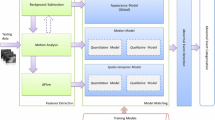Abstract
This paper presents a classifier-based approach to recognize dynamic events in video surveillance sequences. The goal of this work is to propose a flexible event recognition system that can be used without relying on a long-term explicit tracking procedure. It is composed of three stages. The first one aims at defining and building a set of relevant features describing the shape and movements of the foreground objects in the scene. To this aim, we introduce new motion descriptors based on space-time volumes. Second, an unsupervised learning-based method is used to cluster the objects, thereby defining a set of coarse to fine local patterns of features, representing primitive events in the video sequences. Finally, events are modeled as a spatio-temporal organization of patterns based on an ensemble of randomized trees. In particular, we want this classifier to discover the temporal and causal correlations between the most discriminative patterns. Our system is experimented and validated both on simulated and real-life data.






Similar content being viewed by others
Notes
Scale invariance is required in numerous visual surveillance contexts.
References
Amit Y, Geman D (1997) Shape quantization and recognition with randomized trees. Neural Comput 9(7):1545–1588
Bobick AF, Davis JW (2001) The recognition of human movement using temporal templates. IEEE Trans Pattern Anal Mach Intell 23:257–267
Breiman L (2001) Random forests. Mach Learn 45(1):5–32
Breiman L, Friedman J, Olsen R, Stone C (1984) Classification and regression trees. CRC, Boca Raton. ISBN 0412048418
Buxton H (2003) Learning and understanding dynamic scene activity: a review. Image Vis Comput 21(1):125–136
Cucchiara R, Grana C, Piccardi M, Prati A (2003) Detecting moving objects, ghosts and shadows in video stream. IEEE Trans Pattern Anal Mach Intell 25:1337–1342
Dee H, Velastin S (2007) How close are we to solving the problem of automated visual surveillance? A review of real-world surveillance, scientific progress and evaluative mechanisms. In: Machine vision and applications, special issue on video surveillance research in industry and Academic Springer. Springer, New York
Geurts P, Ernst D, Wehenkel L (2006) Extremely randomized trees. Mach Learn 63(1):3–42
Gorelick L, Blank M, Shechtman E, IM, Basri R (2005) Actions as space-time shapes. In: ICCV, pp 1395–1402
Haering N, Venetianer PL, Lipton A (2008) The evolution of video surveillance: an overview. Mach Vis Appl 19(5–6):279–290
Haritaoglu I, Harwood D, Davis L (2000) W4: real-time surveillance of people and their activities. IEEE Trans Pattern Anal Mach Intell 22:809–830
Hu W, Tan T, Wang L, Maybank S (2004) A survey on visual surveillance of object motion and behaviors. IEEE Trans Syst Man Cybern 34:334–352
Kadous M, Sammut C (2005) Classification of multivariate time series and structured data using constructive induction. Mach Learn J 58:179–216
Lee D (2005) Effective gaussian mixture learning for video background substraction. IEEE Trans Pattern Anal Mach Intell 27(5):827–832
Lin W, Sun M-T, Poovandran R, Zhang Z (2008) Human activity recognition for video surveillance. In: IEEE international symposium on circuits and systems, 2008. ISCAS 2008, pp 2737–2740
McKenna S, Jabri S, Duric Z, Rosenfeld A, Wechsler H (2000) Tracking groups of people. Comput Vis Image Underst 80:42–56
Medioni G, Cohen I, Bremond F, Hongeng S, Nevatia R (2001) Event detection and analysis from video streams. IEEE Trans Pattern Anal Mach Intell 23(8):873–889
Moosmann F, Nowak E, Jurie F (2008) Randomized clustering forests for image classification. IEEE Trans Pattern Anal Mach Intell 30(9):1632–1646
Nascimento J, Marques J (2006) Performance evaluation of object detection algorithms for video surveillance. IEEE Trans Multimedia 8:761–774
Ohta N (2001) A statistical approach to backgound suppression for surveillance systems. ICCVÕ01 1:481–486
Oliver N, Rosario B, Pentland A (2000) A bayesian computer vision system for modeling human interactions. IEEE Trans Pattern Anal Mach Intell 22(8):831–843
Orrite C, Martinez F, Herrero E, Ragheb H, Velastin S (2008) Independent viewpoint silhouette-based human action modelling and recognition. In: 1st int workshop on machine learning for vision-based motion analysis (MLVMA’08), in ECCV’08. Marseille, France
Pérez Ó, Piccardi M, García J, Molina JM (2007) Comparison of classifiers for human activity recognition. In: IWINAC (2), pp 192–201
Pérez Ó, Piccardi M, García J, Molina JM (2007) Comparison of classifiers for human activity recognition. In: IWINAC ’07: proceedings of the 2nd international work-conference on nature inspired problem-solving methods in knowledge engineering, pp 192–201
Remagnino P, Tan T, Baker K (1998) Multi-agent visual surveillance of dynamic scenes. Image Vis Comput 16(8):529–532
Ribeiro P, Santos-Victor J (2005) Human activities recognition from video: modeling, feature selection and classification architecture. In: Proc. workshop on human activity recognition and modelling (HAREM 2005), pp 61–70
Simon C (2009) Visual event recognition: application on the caviar video clips and simulated trajectories. Technical report, TELE Lab, UCL, Belgium
Simon C, Meessen J, Tzovaras D, De Vleeschouwer C (2007) Using decision trees for knowledge-assisted topologically structured data analysis. In: International workshop on image analysis for multimedia interactive services (WIAMIS). Santorini
Stauffer C, Grimson W (1999) Adaptive background mixture models for real-time tracking. IEEE Comput Vis Pattern Recognit 2:25–258
Veeraraghavan H, Papanikolopoulos N, Schrater PR (2007) Learning dynamic event descriptions in image sequences. In: CVPR
Wang L, Suter D (2007) Learning and matching of dynamic shape manifolds for human action recognition. Image Process IEEE Trans 16(6):1646–1661
Wehenkel L (1998) Automatic learning techniques in power systems. Kluwer, Boston
Xiang T, Shaogang G (2006) Beyond tracking: modelling activity and understanding behaviour. Int J Comput Vis 67(1):21–51
Yilmaz A, Shah M (2005) Actions sketch: a novel action representation. Comput VisPattern Recognit (CVPR 05), IEEE Comput Soc Conf 1:984–989
Zhang D, Gatica-Perez D, Bengio S, McCowan I (2005) Semi-supervised adapted hmms for unusual event detection. In: CVPR ’05: proceedings of the 2005 IEEE computer society conference on computer vision and pattern recognition (CVPR’05), vol 1, pp 611–618
Author information
Authors and Affiliations
Corresponding author
Rights and permissions
About this article
Cite this article
Simon, C., Meessen, J. & De Vleeschouwer, C. Visual event recognition using decision trees. Multimed Tools Appl 50, 95–121 (2010). https://doi.org/10.1007/s11042-009-0364-y
Published:
Issue Date:
DOI: https://doi.org/10.1007/s11042-009-0364-y




